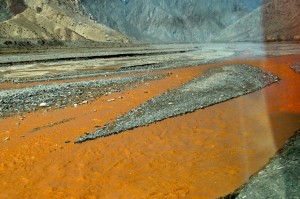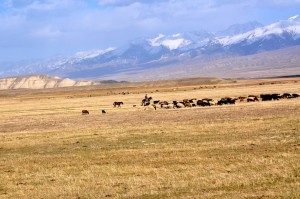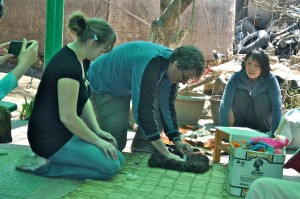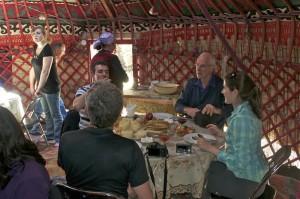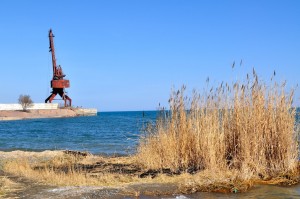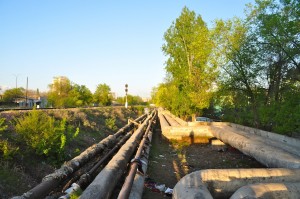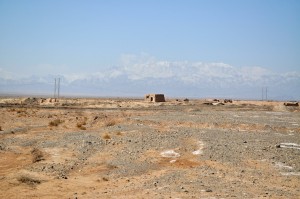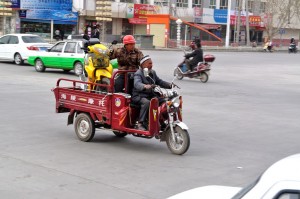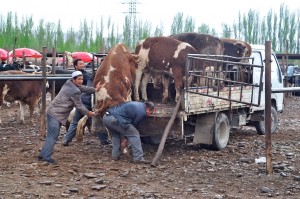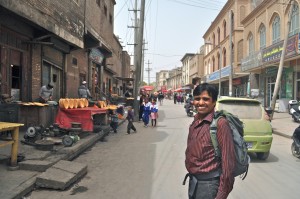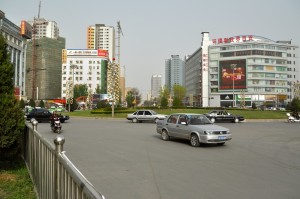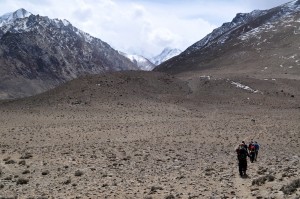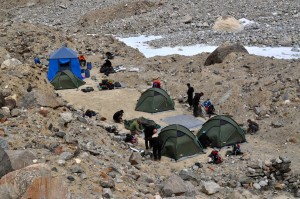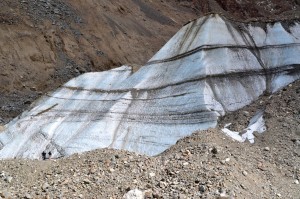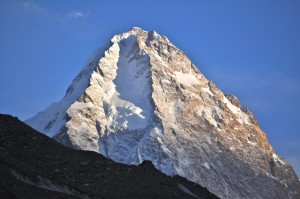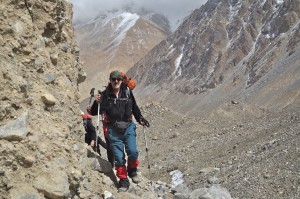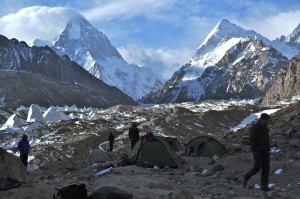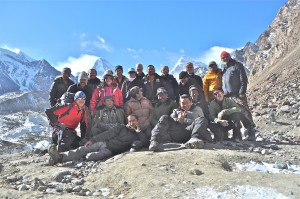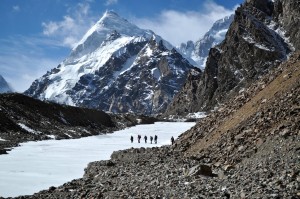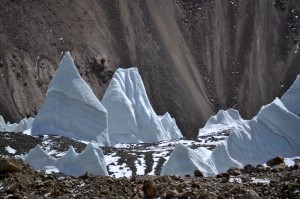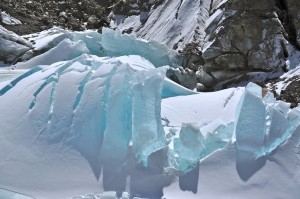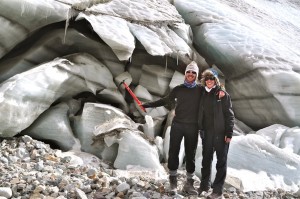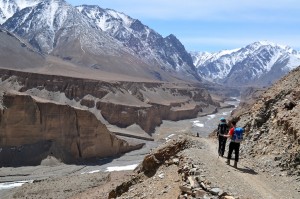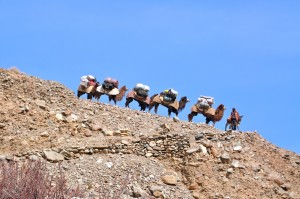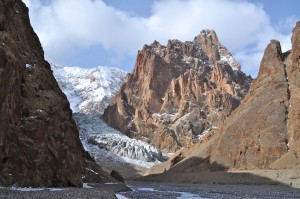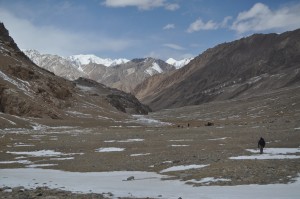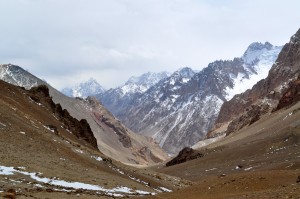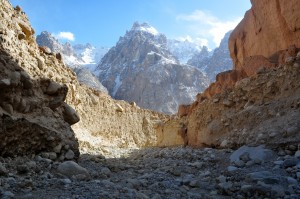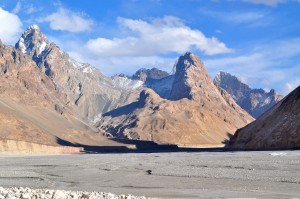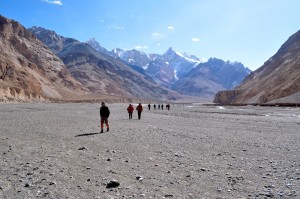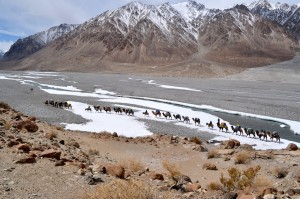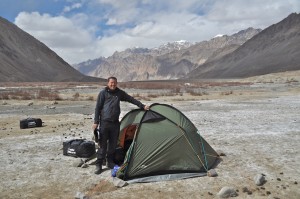Before we left Chinese Base Camp we discussed whether we wanted a rest day, before going back over the Aghil Pass, or to continue through without a rest day and have an extra day in Kashgar. Surprisingly, everybody preferred to finish early and have the extra day in a hotel. As it turned out this was the best decision that could have been made.
Given the freedom to leave camp when we were ready, before the crew were properly organised, we set off, retracing our steps. I don’t enjoy this aspect of linear treks and prefer circular routes, so I put my head down and strode out. When we came to the K2 River we approached cautiously, in case there were any visitors to the dead kiang on the ice. There were none, but it was interesting to note that in the time we had been on the mountain the level of the ice had dropped about a foot, except where the kiang lay, which was now raised on an ice plinth. Crossing the frozen river I was lucky to pick up the camel track across the stones, making walking that much easier. I wish I had found it on the walk in. However, walking on the stony riverbeds becomes tedious after a while and a number of us chose to leave the river at the point where we had lunch the other day. The sand held a number of snow leopard prints suggesting they had been sniffing the remnants of food.
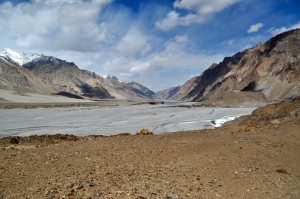
The Sarpo Lago River Valley flowing into the Shagskam River Valley
Climbing up the hill to take the short cut we followed no path in particular but our prints were clear in the very sandy, dusty soil. Others would follow easily. It soon became apparent that we were going much higher on the hill than we did on the outward journey. While some wanted to go higher still in the belief that a shoulder above would give them access to the next valley, I was not convinced and dropped to where I knew we would gain access. Indeed, I was right and, having entered the Shagskam Valley, waited for the others to appear. After 45 minutes the only person to appear, not from the hills but from around the corner, was Tendi. He wasn’t sure where the rest of the group was so we had lunch and waited a further 20 minutes. Still no sign so we headed off.
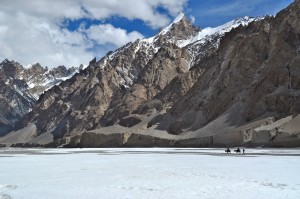
Making use of the ice to speed up the walk
Very close to where we camped on the way up was a large rock sticking out into the valley. I decided to climb to the top to give me a good view to where the others were coming from and so that they could see me. Eventually they all began to filter along the valley and join me. Those that had earlier chosen to climb higher were full of excitement; they had not found a route through but had found a cave with lots of remains and huge bird pellets. What could have been a trudge over a familiar route had turned into a bit of an adventure.
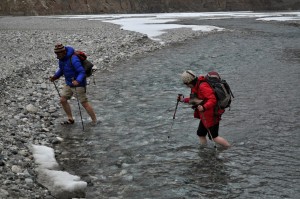
River crossing
Along the Shagskam River there had been a noticeable reduction in the ice and we were faced with a number of river crossings during the afternoon, where only a few days previously we had been able to cross on the ice. Fortunately the river was never more than knee deep where we chose to cross. I don’t think I would have wanted it much deeper as it was still extremely cold. As it was, our feet felt very refreshed and had a much needed wash! We were well equipped this time with our water footwear, all except Rob who hadn’t packed any in the first place. Nigel was feeling either sorry for him or generous towards him and, having crossed the river himself, offered to throw his shoes across for Rob to wear. Unfortunately, Nigel used a girlie underarm technique with the first shoe and it plopped right in the middle of the fast flowing river and disappeared at a rate of knots. Those around were so busy rolling about laughing that they were not able to even attempt a rescue. Perhaps Nigel was just teasing Rob.
Later in the afternoon, just before we reached camp, there was one final river crossing. For this the camels came back to carry everyone. I chose not to take advantage of the camels but to walk through the river as I was already wearing my water shoes, and I wanted to be in a position to film the crossing. I am so pleased I took that decision. David had grown very fond of a particular camel, a blond leggy specimen with long fluttery eye lashes. He eagerly climbed aboard and Robin joined him on the back of the animal. The camel had a fiery personality and bucked from side to side causing both David and Robin to hang on for dear life. I have never seen David look so frightened.
However, David and Robin got off lightly compared with Simon and Chris who rode their placid natured camel with confidence. That was until the camel started to climb up the bank, having crossed safely. Its legs gave way and then it began to slide back down the bank, into the river, dumping Simon into the water, giving him wet feet and, more worryingly, wet boots. Chris managed to save himself and maintained his dignity.
Our camp for that night was further up the valley and on the opposite side from our corresponding outward camp. The camel men advised us that it was a much better camp and would be sheltered from the strong winds that swept through the valley late in the day. It would also make the next day’s walk quite short, giving us some rest before crossing the Aghil Pass. It was certainly an attractive place to camp but because of the stony nature of the ground we could not use pegs, but anchored the tents with large rocks. That evening the wind was so strong we had to lie in our tents to make sure the wind did not carry them away and the mess tent was in serious jeopardy until the wind died during the course of the night.
The weather was now not as clear or as bright as it had been on the way up and it was not getting any warmer. We were only walking for about three hours and, understandably, we arrived at camp before the crew. It was while waiting for the crew to arrive that we realised just how cold it was becoming. Layers were going on to try to maintain body temperatures. The tents could not come soon enough and once they were there they were rapidly erected and people disappeared into them for warmth and shelter from the strengthening wind. As the day progressed the weather continued to deteriorate and by evening snow began to fall.
By morning we had two to three inches of snow and it was still falling. The flakes were incredibly fine and it was a dry snow. Thankfully the fineness of the flakes had limited the depth but we knew it might be a different story on the Aghil Pass, which we still had to cross.
Setting off we first had to cross the mile wide river bed to the mouth of the gorge. It was a steady climb up the boulder strewn gorge bed with the occasional scramble up the still dry waterfalls. We kept a wary eye on the cliffs above just in case a boulder should free itself from its fragile sandy bed. We kept the noise down to a minimum, just in case sound should dislodge a rock. Also, temperature rises can affect the stability of such fragile landscapes so we wanted to pass through this area as quickly as we could. Forty five minutes saw us scrambling out of the gorge and the danger had passed. Fortunately the temperature was not noticeably rising, rather the opposite, in fact.
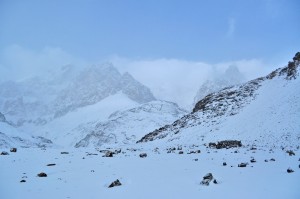
Looking down from the Aghil Pass
We now had to pick our route through a maze of rocks and gullies towards the pass. With height gained the snow deepened and Akbar became less comfortable. It was clear he was being affected by the cold and altitude. He borrowed a pair of gloves off Ann, sunglasses off Hira. He lost interest, focus and direction and it was left to us to route find our way to the top of the pass. While this was happening Mo also began to suffer; lacking energy etc. so we fed him dextrose and I took him to the top doing the ‘Walton plod’. Once on the top he perked up, as did Akbar, and we began the long descent down the other side. This time the wind was not such a factor in our crossing the pass but, instead of being at our backs, as expected, it was in our faces. This meant that there was much more snow gathered on our downward slope and for much of the time it was knee deep, with many dips and tussocks for us to twist an ankle beneath the surface.

Frozen beard
Taking time for the camels to catch up and overtake we paused for lunch. My beard was a frozen mass of icicles. The camels, now ahead of us, paved the way, flattening the snow and making walking much easier and safer. It was a long descent, about three hours, and just before camp I caught up with the camels. I was intrigued by how quiet and placid they were. They required no instruction or encouragement, they just plodded on their dinner plate sized feet, flattening the snow for me to follow. It was the same when they reached camp. A little click of the tongue instructed them to sit so they could be unloaded and a second click told them to stand again.
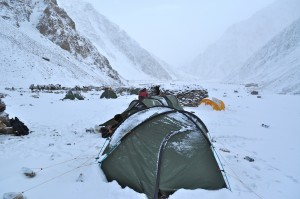
Camp at Kotaz
As we arrived in camp it started to snow more heavily, making the putting up of tents a miserable affair. Once up, we snuggled down to keep warm. We did not bother with the mess tent and our food was brought to us. Spending so long (14 hours on this occasion) in a horizontal position was not doing my back any good. It had been the same on the glacier a few days previously
It snowed all night. When we woke up we realised just what a good decision it had been not to take a rest day before the Aghil Pass. Had we done so we would not have been able to cross. The snow would have been getting on for waist deep, and while we might have been able to exhaustingly plough our way through, the camels and donkeys would not. We would have been stuck on the wrong side of the pass, certainly for another day, probably more, with diminishing supplies of food and gas.
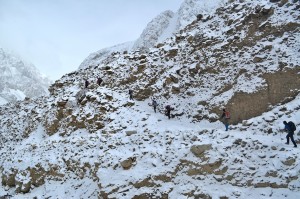
Rising above the valley
Now that we were over the pass our journey over the next two days should be easier. We just had one more obstacle to overcome in the conditions. Travelling down from camp the valley narrows to such an extent that the river, when not frozen, flows through a notch only a few feet wide. It is impractical for the path to follow the river, so it climbs above and undulates on a narrow path some distance above on the cliffs. In the snowy conditions the path proved quite treacherous and care had to be taken not to tumble to the rocks and ice below.
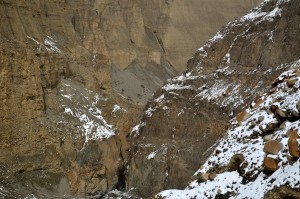
Bypassing the narrow cleft in the valley
Successfully negotiated, the valley opened out again and we were able to enjoy the walk to camp at Sarak. Towering cliffs rose on either side and our path hugged the left bank of the valley. The likelihood of a rock dislodging from the cliff as we walked by was slim but there was plenty of evidence of rocks having fallen on to the path.
By the time we reached camp all the snow had gone, not melted, but evaporated, leaving the ground as dry as it had been before any snow had fallen. There had been a mist hanging over us all day and I can only assume it was brought about by this evaporation process.
In the morning more snow had fallen but it did not last long as the sun soon cleared it away. We only had to walk the short distance to Yilik, estimated to be about four hours. In fact it only took some of us three hours as we put our heads down and got on with the job. Once we entered the Yilik Valley we were faced with a strong, cold wind but after, what seemed an endless trudge to the village, we reached the shelter of the house that was hosting us.
When we had left Yilik two weeks previously there were signs that some building work was going to take place a short distance from the village. On our return a crane was in place and the shells of several buildings had been erected. This is all part of the Chinese policy of rehousing communities out of their mud constructed houses and into more modern, but less individualistic houses. Whether there is any choice in the matter I do not know. I doubt it!
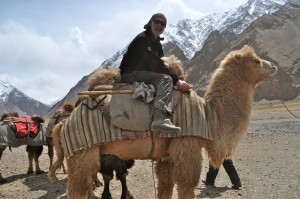
David cements his relationship with 'Blondie'
When everybody finally arrived at Yilik we all had an opportunity to ride the camels briefly. David, determined to make amends for his girlie screaming three days previously, girded his loins and mounted Blondie. She was far more accepting this time.
Related Images:

